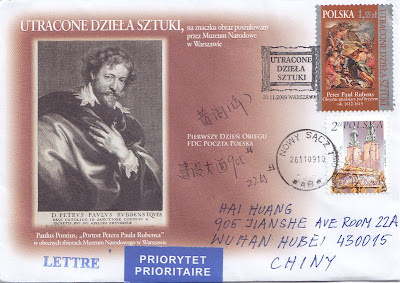
This is the first cover I received for this blog.
The first stamp depicts "Great Tit", a very common songbird in Euroasia; The second is "Euroasia Capercaillie",the largest member of the grouse family.
The last stamp is the Spanish 2009 Upaep issue of Tradition Game: La Baraja Espanola
The Baraja española is made up of 48 cards divided into four suits: bastos (clubs), oros (golds, that is, golden coins), copas (cups) and espadas (swords). All suits are numbered from 1 to 12, corresponding to the pictures of the sota, (page or prince), the caballo (knight, literally “horse”), and the rey (king) and the numbers 10, 11 and 12 respectively. Usually only 40 cards are used since the eights and the nines are discarded. In the Spanish deck, the drawings are depicted in full body and they are framed by a pattern to distinguish the different suits without having to display the cards. The cup’s pattern is a line with one interruption, swords have two, clubs have three and the golds have a continuous pattern with no interruption.
Cards are thought to have their origin in a numeric pastime and so are depicted in different European tapestries of the XIV and XV centuries. There are many designs depending on the different countries and periods in time, the oldest ones made in rich handicraft for the lords. The themes depicted are also varied and most of them related to art, heraldry, mythology, politics and music. They are usually rectangular shaped although they have also been made squared and rounded.








